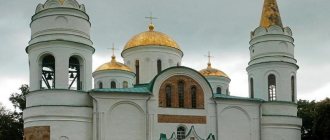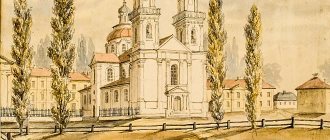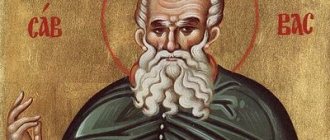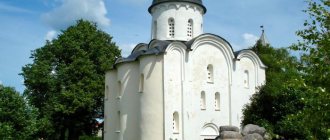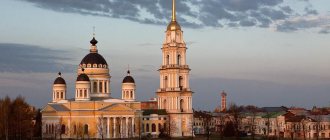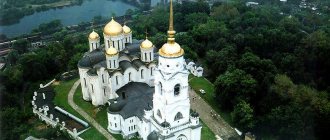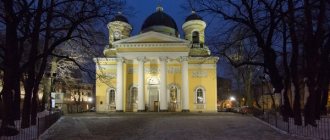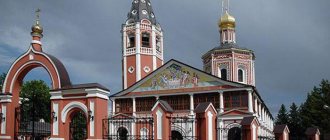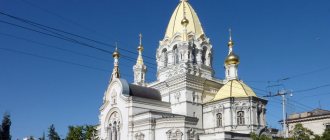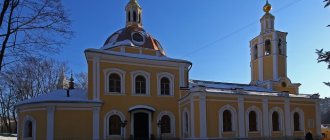The Peter and Paul Cathedral in Simferopol - one of the oldest Orthodox churches in the capital of Crimea - is well known to many both on the peninsula and far beyond its borders. It is relatively small, especially for a cathedral parish, but it is quite beautiful and fits harmoniously into the surrounding landscape, literally attracting admiring glances. Although it can hardly be called a symbol of the city, its most striking attraction, rarely does a tourist pass by without visiting this beautiful building.
- Where is the temple located in Crimea?
- History: prerequisites for construction
- The further fate of the Peter and Paul Church
- What is interesting about the Cathedral of Peter and Paul?
- How to get to the cathedral?
Peter and Paul Cathedral
The Cathedral of the Holy Apostles Peter and Paul in Simferopol is the most valuable heritage of the peninsula, dating back to the end of the 17th century, when the reign was in the hands of Catherine the Great.
During its existence, it was built three times: either the clock left its mark, or the authorities began to destroy everything connected with religion. But with the help of caring residents who really need the Abode of the Heavenly Father, the building has been preserved to this day. This gives you a chance to come here and feel all the greatness that comes from this modest building.
This is interesting: Sandy Bay in Sevastopol, Crimea: on the map, photos, beaches, reviews
How to get to the cathedral?
Getting to the Peter and Paul Cathedral by public transport is easy. Several routes go from the Simferopol bus station in its direction. When you take minibus No. 114, you need to get off at the stop “pl. Lenin", by bus No. 64 - "st. Mokrousova". Other modes of transport also come here.
By car you can get to the attractions of Simferopol as follows:
Note to tourists
- Address: Proletarskaya street, 5, Simferopol, Crimea, Russia.
- Coordinates: 44.949818, 34.10536.
- Phone: +7-365-229-79-71.
- Official website: https://cspp.prihod.ru/
The Peter and Paul Cathedral in Simferopol is often called the most interesting Orthodox church in Crimea, and many argue that after its revival it has become even more beautiful. Whether this is true or not, anyone can find out if they visit it or at least the official website of the church.
Liked? Share with your friends!
Revival of a church building
Residents of Simferopol decided to give new life to the Peter and Paul Cathedral in 1866. For this purpose, they created a special construction committee, the project of the new building was carried out by the architect K. Lazarev, who arrived from St. Petersburg. For the revival, it was necessary to collect the required amount of money, most of which was contributed by parishioners, the rest by the Holy Synod. Rich merchants involved in the church affairs of the city also took part in fundraising.
- In the summer of 1866, the wooden building was dismantled and the first stone was laid. Parishioners took an active part in this pious act, professional engineers supervised the construction work, and prominent craftsmen were responsible for the installation of the iconostasis.
- The construction of the cathedral frame was completed two months later, but finishing continued for four years. The new temple had a different shape - cruciform, extended from the west to the east.
- The church gained significant space due to the larger number of windows placed in the dome drum. Inside, the room benefited from the inimitable iconostasis, made in the Byzantine style.
- The finishing work was completed at the end of the summer of 1870, and the temple opened its gates to the Orthodox parishioners of Simferopol. There was a special guardianship under the church, as well as male and female schools.
- At the end of the 19th century, the Peter and Paul Church was surrounded by an openwork metal fence, and strong trees and graceful shrubs were planted inside the courtyard. In front of the building there was a small space paved with stone. Over time, low houses began to appear nearby.
What is important to know about the Orthodox faith:
- About the Ten Commandments
- Fasting in Orthodoxy
- About Orthodox symbols
On a note! In 2008, the discovery and transfer of the remains of St. Gury took place in the Peter and Paul Church in Simferopol. Soon celebrations took place and the date of the saint’s memory was set - March 17. After the Divine Liturgy, a prayer service was served before the remains of Guria, and the parishioners began to venerate this relic. The relics were transferred to the A. Nevsky Cathedral after it was restored.
Holy relics of St. Gury in the Peter and Paul Cathedral
Practical information
Address: Simferopol, st. Proletarskaya, 5. Website.
You can get there by bus or trolleybus going to the Lenin Square stop.
Services are held from Monday to Saturday at 7:30 and 16:00. On Sunday - at 6:30, 9:00 and 16:00.
Coming soon on “Subtleties”: There is no arguing with this: 5 rules that a tourist should not break
Data confidentiality is guaranteed, you can unsubscribe at any time
Thank you! Now you will receive (no more than once a week) our proprietary digest. All that remains is to confirm your subscription using the link in the letter we sent you.
Other attractions nearby
- Museum of Local Lore of Simferopol
- Catherine's Garden
- Observation platforms of Simferopol
But this is unnecessary
Simferopol and surroundings
- Where to stay:
the gateway to Crimea and the capital of the peninsula, Simferopol is an ideal accommodation option for those who do not crave sea entertainment, but are ready to devote their leisure time to getting to know a huge number of historical attractions. If you want to be closer to the sea, you can pay attention to Yalta, Sudak or Gurzuf. In the end, the Olympic beauty of Sochi, located across the bridge, awaits its guests. - What to see:
in Simferopol, the first thing you should do is go to the historical center to see the cathedral, mosque and kenassa, mansions of the 18th-19th centuries and long-lived trees: 750-year-old oak, plane trees and chestnut. A little further to the outskirts there are ancient noble estates, Paleolithic monuments and ancient settlements. Well, after getting out of the city, it’s worth going to Lake Mars and the Jur-Jur waterfalls, see the cave city of Bakla and go down to the Marble and Emine-Bair-Khosar caves. - You may also be interested in Greece, Türkiye, Abkhazia, Germany, Finland.
- The most popular Russian cities and regions: Golden Ring, Kazan, Moscow, St. Petersburg, Sochi.
- 5 museum-reserves in Russia telling about bygone days
- 5 small towns in Russia you'll want to stay in
- 7 best places in Russia to relax during the autumn holidays
- Free vacation for Russians: rules, numbers, pitfalls
- Muscovites and non-Muscovites: what is the difference and how to live with it. 7 observations
- New Russian cities that cause surprise and delight
- Experts named the 5 most beautiful waterfalls in Russia
- Russia for foreigners
Even more interesting things in Russia
Relics
Lost Relic
According to the testimony of Bishop Hermogenes (Dobronravin), in the Cathedral of Peter and Paul there was preserved “a wonderful ancient icon of the Holy Trinity with part of the Lord’s robe in the reliquary and with particles of the relics of the holy saints depicted on the icon, in a silver-gilded cross, with the inscription 1693.” According to legend, during the Crimean War an unknown officer left the icon in the church with the condition that at the end of the war he would return for it, but if not, it would remain in the church. The war ended, but no one came for the icon.
Relics in the temple
- Icon with the relics of St. Nicholas
- Icon of the Mother of God “Iverskaya”
- Icon of the Most Holy Theotokos Three-Handed
- Relics of Saint Gury (Karpov), Archbishop of Tauride
- The revered icon of St. Nicholas the Wonderworker and the imprint on the glass of its icon case
- Cross with a particle of the Honest Life-Giving Cross of the Lord
Cathedral of the Holy Apostles Peter and Paul in Simferopol
Description
Link to text source.
It was built at the beginning of the 19th century at the request and at the expense of the residents of Simferopol (the official founding date of the city is 1784), while the Tatars called this place Ak-Mosque (white mosque).
The writer, senator and member of the Russian Academy Pavel Ivanovich Sumarokov (not to be confused with the poet Alexander Petrovich Sumarokov), visiting Simferopol in 1803, wrote in “Leisures of the Crimean Judge” that he found “one Russian church (Konstantin-Eleninskaya - author’s note). ) in the poorest Tatar house, built for the Vladimir Bombardier Regiment that was stationed here, and one Greek one. And the population of the city consisted of 66 nobles, other Russian residents of various ranks, such as merchants, artisans, workers and others, a total of 360 souls; Greeks 42, Armenians 31, Germans 10, Moldovans 19, Jews 32, subjects of the Caesars 25 and Turkish subjects 50; only up to 1 thousand souls, not counting the quartering troops.”
The construction of a new church, for which Orthodox parishioners collected funds, began in 1805, and on November 8, 1806, the new church was consecrated. It was made of wood - within one's means, so to speak, without paintings; the main decoration was the iconostasis. The bells for the Peter and Paul Church were cast from copper left over after the closure of the Ak-Mosque mint.
More than twenty years later, the dilapidated temple was closed. A new cathedral, Alexander Nevsky Cathedral, was erected in the city, where bells, church utensils, and a sacristy were transferred from the Peter and Paul Church.
In the second half of the 19th century, in Crimea, through the efforts of St. Innocent, Archbishop of Kherson and Tauride (in the world Ivan Alekseevich Borisov), a new diocese of the Orthodox Church was opened. Activities of St. Innocent is widely known in the Orthodox world not only for her significant patriotic and spiritual activities during the Crimean War. Thanks to the saint, the borders of the diocese expanded, monasteries were revived, the position of Christianity on the peninsula was strengthened, and active construction of new churches and reconstruction of old churches began.
In 1865, the residents of Simferopol decided to revive the Peter and Paul Church, for which they created a construction committee, which included former church warden Afanasy Ivanovich Tisov, priests Rudnev and Lisnevsky, deacon Antip Shtenko, honorary citizens Kuzmin and Startsov.
It is symbolic: the project of the new temple was developed by the architect from St. Petersburg K. Lazarev. Of the 55 thousand rubles required to implement the project, 32 thousand were collected by parishioners, and 23 thousand were allocated by the Holy Synod. To complete the work, the merchant Tisov, who served as church warden of the Peter and Paul Cathedral for more than 20 years, donated 15 thousand rubles, and after his death he was buried in the left aisle of the temple.
The old wooden church was dismantled, and a new building was founded in its place on June 29, 1866. Contract work was supervised by K.K. Vorontsov, and provincial engineer Grachev supervised the work. In August 1866, construction of the church was completed, but finishing work continued for another 4 years. The temple, built in the shape of a cross, had 12 windows arranged in a drum. The interior decoration of the temple was particularly elegant. The iconostasis, made by master Zaitsev, with icons of the Byzantine style, delighted with its beauty.
Services in the Peter and Paul Church resumed on August 16, 1870, but already from 1868, parish guardianship, as well as men's and women's schools, operated at the church.
Thanks to the testimony of Bishop Hermogenes, we know that in the Cathedral of Peter and Paul there was preserved “a wonderful ancient icon of the Holy Trinity with part of the robe of the Lord in the reliquary and with particles of the relics of St. saints depicted on the icon, in a silver-gilded cross, with the inscription 1693.” A touching story is told about this shrine. During the Crimean War 1853-1856. an unknown officer left the icon in the Peter and Paul Church with the condition that at the end of the war he would return for it, and if not, he bequeathed to leave it in the temple. Most likely, the icon was a family shrine. The pious officer did not return from the war. And the icon was carefully preserved in the temple; on Thursdays, an akathist was read in front of it.
In 1890, the parishioners surrounded the church yard with an openwork metal fence, planting trees and ornamental shrubs in the yard itself. Military parades and folk festivals took place in a small square paved with cobblestones. The area around the Peter and Paul Church and the square was gradually built up with one- and two-story houses - since the buildings around the church should not be high for the cathedral to be clearly visible from all sides.
In 1902-1903 Young artists from the Academy of Arts, funded by the church warden S.I. Abrikosov, painted the dome of the cathedral. In the very center the Lord of Hosts was depicted surrounded by the Heavenly Powers, the walls between the windows were decorated with ornaments, and 12 medallions with images of the holy apostles were written along the belt of the drum. In the next two years, the painting of the walls was completed.
Divine services in the Peter and Paul Cathedral ceased in the godless year of 1937, terrible for our Fatherland. The Bolsheviks dismantled the dome and bell tower, set up a warehouse in the church, and next door there was a collection point for glass containers and a beer hall, for which, apparently, there was no better place.
Moving away from unconsciousness, embitterment and oblivion of faith, the authorities began restoring the Peter and Paul Cathedral in the late 1980s. Thanks to the extensive research work carried out by S. L. Belova in the archives of the Synod, it was possible to find projects according to which the bell tower and dome of the temple were restored. The author of the restoration project was the architect O. I. Sergeeva, and the work was carried out by Krymrestavratsiya CJSC.
The modern architectural appearance of the church combines elements of different styles: classical forms are organically combined with the forms of ancient Russian architecture. The tall windows are decorated with white stone frames. The upper part of the building is decorated with a stepped cornice and zakomari, in which round niches are arranged. The building is crowned with a light drum with an “onion-shaped” dome; at the entrance to the temple there is a porch; there is a stone staircase, above which rises a bell tower. The main entrance is framed by thin semi-columns; bright mosaic images of Jesus Christ, as well as the holy apostles Peter and Paul, look out at the parishioners from the façade.
The temple has two chapels - in honor of St. John of Kronstadt and St. Seraphim of Sarov.
Since 2003, the Peter and Paul Cathedral was given cathedral status.
Diocesan sources report that in 2004 a miracle occurred in the church - on the glass behind which stood the icon of St. Nicholas the Wonderworker, his miraculous face appeared. This glass is also now displayed next to the icon for the worship of believers.
Let us recall that a similar miracle with the imprint of the Image on the glass of the icon case occurred in 1993 in Kyiv, in the Holy Vvedensky Monastery with the Mother of God icon “Look at Humility.”
Speaking about the St. Peter and Paul Cathedral in Simferopol, one cannot help but remember that here lie the holy relics of the Crimean Saint Guriy Karpov, Archbishop of Tauride, glorified not only as a locally revered saint in the lands of Tavria, but also in China, where, having been a bishop for 18 years, he carried the light of the Orthodox faith. The glorification of Saint Gury as a saint took place in the same church in August 2008, the solemn glorification of Archbishop Gury as a saint was led by the Primate of the Ukrainian Orthodox Church, His Beatitude Metropolitan Vladimir of Kiev and All Ukraine.
Now, next to the place at the altar where the holy relics of Archbishop Guria permanently reside, there is a festively decorated icon of the “Cathedral of the Holy Chinese Martyrs.” It is assumed that when the Alexander Nevsky Cathedral, which was blown up in 1930 and housed the episcopal see of Archbishop of Tauride Gury (Karpov), is recreated in the Crimean capital, his holy relics will be transferred to this revived cathedral church.
And now it is the St. Peter and Paul Cathedral that constantly receives testimonies of healings and miracles that are happening in our days through the prayers of St. Gury.
Sacred Relics
Having gone through several stages of devastation, desolation and restoration, the cathedral was a confirmation of the unbending spirit of the Orthodox people. Anyone can visit this divine place; you just need to follow the rules of behavior and dress appropriately. Staying in the cathedral will give you a feeling of relief from the daily hustle and bustle.
The Peter and Paul Church contains several sacred relics, in front of which it is worth saying sincere prayers in order to gain the correct vision of things.
- Parishioners can touch the relics of St. Nicholas the Wonderworker, who is extremely revered throughout the Christian world.
- The Iveron Icon of the Mother of God is kept in the church, comforting in sorrows and giving fertility.
- In the same place you can see and sing prayers to the sacred image of the “Three Hands”, which bestows health and family well-being.
- The iconostasis contains the “Transfiguration of Christ” icon, depicting the ministry of the Savior on Mount Tabor.
These relics are consecrated by the church and are the object of deep worship, because they introduce people to true religion and teach people to be more righteous.
Important! The clergy assure: particles of relics and icons are direct carriers of the blessed energy sent by God to the earth.
This is interesting: Peter and Paul Cathedral in Sevastopol: address, photo of the temple, reviews, description
Description
Interior of the temple
The architectural style of the temple combines elements of different styles: classics are combined with the forms of ancient Russian architecture. White stone frames frame the tall windows. The upper part of the building is decorated with a stepped cornice. The building is crowned with a drum with 12 windows. The dome has the shape of a black “onion”. At the entrance to the temple there is a porch, a stone staircase, above which rises a bell tower. The main entrance is framed by thin semi-columns, and on the façade you can see bright mosaics depicting Jesus Christ and the holy apostles Peter and Paul.
The temple has two side chapels: in the name of John of Kronstadt and Seraphim of Sarov.
Peter and Paul Cathedral
The Cathedral in the name of Saints Peter and Paul was built in 1805 at the request and at the expense of the residents of Simferopol and operated until the construction of the Alexander Nevsky Cathedral.
On November 8, 1806, the Peter and Paul Cathedral was consecrated. It was made of wood, with a large bell tower and a pentagonal apse. The main decoration of the temple was the iconostasis. For twenty years, copper bells called parishioners to prayer. Over time, the church fell into disrepair, and in 1865 a committee was created to revive it. The project of the new temple was developed by the architect K. Lazarev. Using funds raised by parishioners in June 1866, a new stone church was laid on the site of a dilapidated wooden church.
On August 16, 1870, the construction of the Peter and Paul Cathedral with a high hipped bell tower was completed. Contemporaries noted the special elegance of the decoration of the temple. Under him, a parish trusteeship and men's and women's schools were opened. In front of the temple there was a small square paved with cobblestones. All military parades and public festivities took place there.
The Peter and Paul Cathedral was constantly updated. In 1902-1903, painters from the Academy of Arts painted the dome, and in the next two years, the walls.
Temple interior. Photo from the site https://www.krim-palomnik.ru
Reconsecrated in 1870, it operated until 1937, when it was closed and turned into a warehouse. For more than 40 years, the temple was in disrepair: there were no crosses decorating its dome, there was no bell tower or fence. A concrete ramp was made to allow trucks to enter the building. There was a collection point for glass containers and a beer hall.
In the 1980s, restoration of the Peter and Paul Cathedral began. Restoration of the temple according to the project of architect O.I. Sergeeva was in charge of Krymrestavratsiya CJSC.
In the 1990s. the temple was restored. The cathedral has been restored to its original appearance. Now there are two chapels in the temple: in honor of Saints John of Kronstadt and Seraphim of Sarov. Thanks to the efforts of restorers, the cathedral has become even better than it once was: the modern appearance of the building combines classical forms and elements of ancient Russian architecture, the entrance to the temple is framed by thin semi-columns with mosaic images of Jesus Christ, Saints Peter and Paul, a light drum with an “onion” shaped dome complete the beautiful view of the temple.
On July 12, 1991, on the feast of the apostles Peter and Paul, after many years of desolation, the words of prayer were heard again in the revived church.
Since 2003, the Peter and Paul Cathedral has been given cathedral status.
Since 2008, the cathedral has housed the holy relics of St. Gury (in the world Grigory Platonovich Karpov, 1814-1882), Archbishop of Tauride. Previously, the relics were in the crypt of the Alexander Nevsky Cathedral.
Address: st. Oktyabrskaya, 16.
History: prerequisites for construction
The appearance of the temple is due to the well-known journey of Empress Catherine II through the vastness of the peninsula. While passing through the then small and provincial Simferopol, the empress noticed that in the entire city there was only one parish -
the wooden Church of Constantine and Helena, which was in deplorable condition, more like a shack. The ruler made a caustic remark to Prince Potemkin, the then governor-general of the Novorossiysk region, and those close to the “most serene” took this as a guide to action.
Construction of the first church
Construction of the church named after Saints Peter and Paul began under Catherine’s grandson - in 1805, after the approval of the Holy Synod. The construction of the first temple lasted a little more than a year - by the autumn of 1806, the new building towered over the surrounding area. It had a rectangular shape with a pentagonal apse located on the eastern side and a high bell tower on the western side.
In the internal part, the complex was divided into three naves - with a high central one and two smaller ones on the sides. The decoration of the church was neither particularly splendid nor splendid - its only decoration was the stunningly beautiful iconostasis, which stood out especially against the general background. By 1825, it had become so dilapidated that, out of concern for the life and health of parishioners, it had to be closed that same year.
Construction of a new cathedral
40 years later, thanks to the care and efforts of the townspeople who decided to revive the Peter and Paul Church on this site, the construction of a new, this time stone, structure began. Concerned residents collected 32,000 rubles for this purpose, and another 23,000 were allocated by the Holy Synod. The construction was entrusted to Konstantin Lazarev, a little-known St. Petersburg architect at that time, who immediately seized on this opportunity and enthusiastically set to work in 1866.
Construction progressed quite quickly: by the end of summer the architect had completed the main work, although the exterior and interior decoration took another 4 years. In 1870, the new church was consecrated and opened to parishioners. Simferopol and its residents accepted the renovated Peter and Paul Cathedral with warm gratitude and appreciated the work of the St. Petersburg architect.
History of the cathedral
The Holy Synod issued permission for construction only in 1801, despite a special decree of Catherine II that had been issued earlier. The highest body of church government has been considering this issue for a long time. Members of the Synod carefully studied documents about the number of residents in Simferopol and the reasons that prompted the construction.
The Orthodox believers of Simferopol needed a spacious church, because the small cathedral in honor of Constantine and Helena was not able to accommodate everyone who wanted to take part in the services.
- The foundation of the temple was laid in 1805, funds were collected exclusively by the local population. The consecration of the building took place the following year at the beginning of November.
- The temple was a rectangular building made of wooden beams. On the eastern side there was a pentagonal apse (altar ledge), and on the western side there was a remarkable bell tower.
- The interior was divided into three naves (elongated rooms) using eight pillars. There were no wall paintings in the new cathedral; the only decoration was an elegant iconostasis. The material for the bell was copper, which remained after the destruction of the Simferopol mint.
- The Cathedral of Peter and Paul existed in its original form for two decades, but soon fell into disrepair and was closed. Another church was built in the city, consecrated in honor of Alexander Nevsky. The sacristy, bells and various church utensils from the Peter and Paul Church were moved here.
Interesting!
Bishop Hermogenes claimed that the sacred image of the Trinity was kept in the cathedral. The icon contained part of Christ's tunic and some remains of saints depicted on the canvas. The legend says: an unknown officer left this image in the church, and he himself went to defend his homeland during the Crimean (Eastern) War of 1853-1856. He promised to return for the icon, but did not keep his promise. At the moment, this sacred relic is considered lost.
Interior of the Cathedral of Saints Peter and Paul
Shrines
- Relics of Saint Gury, Archbishop of Tauride
- Icon of the Holy Martyr Sergius
- Cross with a particle of the Honest Life-Giving Cross of the Lord
- The revered icon of St. Nicholas the Wonderworker and the imprint on the glass of its icon case
- Icon with the relics of St. Nicholas
- Icon of the Mother of God “Iverskaya”
- Icon of the Most Holy Theotokos Three-Handed
- Icon of the Transfiguration of the Lord
Reliquary:
- Great Martyr George the Victorious
- Venerable Euphrosyne of Suzdal
- Venerable Gregory of Sinaite
- Saint Basil, Bishop of Ryazan
- Saint Ignatius, Bishop of Rostov
- Saint Innocent, Archbishop of Kherson and Tauride
- Saint John, Bishop of Suzdal
- Saint Tikhon, Patriarch of Moscow and All Rus'
- Saint Theodore, Archbishop of Rostov and Suzdal
- Holy Blessed Prince Alexander Nevsky
- Holy Blessed Prince Peter of Murom
- Saints David and Constantine of Yaroslavl
Top 6 Orthodox churches in Simferopol
Now we will talk about the top 6 Orthodox churches in Simferopol. This article is written like the 5 top churches in Sevastopol, which you can read about by following the link. So, let's go.
Alexander Nevsky Cathedral
Today it has the status of the main temple of the Simferopol and Crimean diocese. It houses the bishop's see and regularly holds divine services by the local bishop (at the time of writing this function was performed by Metropolitan Lazar).
Alexander Nevsky Cathedral
The cathedral was built in 1829 and is considered one of the oldest in Crimea, built during imperial times. A century later, it was blown to the ground by the Bolsheviks in 1930. Restoration work is still ongoing. The lower church, where the relics of St. Gurias rest, has already been completely restored. The outside of the temple has also acquired finished forms, but the interior decoration of the main upper temple is still ongoing.
The cathedral attracts with its volume and colossal scale of architectural and construction work. Magnificent columns rise in front of the massive central entrance. The temple is richly decorated with expensive decoration.
The religious building also contains other shrines, in addition to the relics of St. Houri. This is a particle from the hand of Lazarus of the Four Days, a particle of the relics of Alexander Nevsky, etc.
It is interesting that during the next renovation work at the end of the 19th century, the young Maxim Gorky worked in the cathedral. In addition, a liturgy was served in the church, led by Bishop Feofan (Bystrov) with anathema (excommunication from the Church) of Leo Tolstoy for his anti-church philosophical teaching.
Holy Trinity Cathedral
It has the status of the cathedral of the Simferopol and Crimean diocese of the canonical Orthodox Church of the Moscow Patriarchate. Located on the territory of the Holy Trinity Convent.
Holy Trinity Cathedral
The main feature of the temple is the presence in it of the relics of such a famous saint in the Christian world as St. Archbishop Luke (Voino-Yasenetsky), doctor of surgery, professor of medicine. In addition, the building contains the miraculous icon of the Mother of God “Sorrowful” and many particles of the relics of saints.
The religious building was built on the site of a Greek wooden church in 1868 (the previous church was built in 1796). The temple is decorated with classical architectural forms. There are large mosaic images on the façade. The cathedral is considered the main shrine of Simferopol.
Peter and Paul Cathedral
It also has the status of a cathedral, often called “old” instead of the “new” Alexander Nevsky being restored. Built on the site of a wooden church (founded in 1806) in 1866. To this day it retains its original appearance, since it was not destroyed during Soviet times, although it was closed.
Peter and Paul Cathedral
The religious building accommodated different architectural styles, such as classical and ancient Russian. The main entrance is framed by exquisite semi-columns. The facade is decorated with mosaic images of Jesus Christ and the apostles Peter and Paul. The cathedral has two side chapels in honor of Seraphim of Sarov and John of Kronstadt.
The church contains a large number of shrines. There are such rare relics as a piece of the Holy Cross, a piece of the Oak of Mamre, a miraculous glass icon of St. Nicholas the Wonderworker. In addition, the temple contains particles of the relics of Peter and Paul, St. Nicholas the Wonderworker, Great Martyr Panteleimon, St. Gury (Karpov) and many others. The revered icons of the Mother of God “Iverskaya” and “Three-Handed” are kept. It’s even hard to believe that such shrines described above are kept in the Crimean land.
Temple of Constantine and Helena
In fourth place among the top 6 Orthodox churches in Simferopol, we placed the very first city church in honor of the Holy Equal-to-the-Apostles Princes Constantine and Helen (these saints are especially revered among the Greeks). The building was built on the site of a former Tatar hut, which was bought by ktitors in 1785, so that the Russian garrison could celebrate Christian services.
Temple of Constantine and Helena
The church was visited by Empress Catherine II in 1787, during her tour from St. Petersburg to Crimea. It was she who ordered the construction of a “spacious” temple (later the Peter and Paul Cathedral), seeing the smallness and simplicity of the only monastery of Christ in the capital peninsular city.
The church contains particles of the relics of Saints Constantine and his mother Helen. Christians of the city most often get married in the described religious building. Children are often baptized there. The temple is small but very elegant. It contains old Russian icon painting.
Church of All Saints
It is one of the oldest city churches (in 2014 it celebrated its 150th anniversary). It is the only one on our list of the top 6 Orthodox churches in Simferopol that did not close during the Soviet period and continued to function. Retained its original appearance. The church is often called “cemetery” because of its proximity to the old necropolis, where people are no longer buried. But the tradition of holding funeral services for Christians in the city continues.
Church of All Saints
Such outstanding figures as Bishop Mikhail (Gribanovsky), Saints Luke (Voino-Yasenetsky) and Guriy (Karpov) were buried in the church fence before their glorification.
The church was built in the classic imperial temple style. She is quite simple and cozy. It contains an outstanding relic: the icon of Christ the Savior, displayed as a negative on glass. The assembled scientific commission came to the conclusion that the image was not made by hands. The chemical composition of the displayed icon consists of 2 organic acids and wax.
Temple of the Three Saints
In another way, the church is called “seminary”, since it was originally built to care for seminarians studying. It is one of the oldest religious buildings in the city. Built in 1902 and still standing today.
The temple was built in the form of a medieval basilica with the addition of a classical Russian five-domed structure. The Old Russian style is made in the manner of the century before last with the addition of some classical elements, the basis of the church is basilica. The religious building is oblong in shape and can accommodate a large number of believers.
Temple of the Three Saints
The building contains particles of the relics of St. Luke and St. Guria (this is not surprising, since their entire relics are located in Simferopol itself). During the service there is an opportunity to listen to the male seminary choir performing both classical tunes (Znamensky and others) and Byzantine ones. But sometimes a hired female (mixed) choir also sings in the choir. You can often spot young girls in the church wanting to meet future clergy.
With the church described, we end our top 6 Orthodox churches in Simferopol.
Read in our section the top 3 religious buildings of other remarkable cities of the Crimean Peninsula. comments powered by HyperComments
A new page in history
When the decision was made to rebuild the Peter and Paul Cathedral, the wooden structure of the temple was dismantled to its foundations in 1866, and in its place, a new cathedral was erected in its place according to the design of the novice St. Petersburg architect K. Lazarev. The cost of construction was 55 thousand rubles, and 32 thousand of them were again donations from city residents.
The newly built cathedral had the shape of a cross and a light drum with twelve windows. The interior decoration of the cathedral was distinguished by its special elegance: the iconostasis in the Byzantine style was created by the hands of the famous master Zaitsev.
The Peter and Paul Cathedral opened its doors to parishioners again on August 16, 1870. Now it was a beautiful temple with rich decoration, it was especially loved by the residents of the city, and throughout its long history they were constantly engaged in its improvement. Paintings in the form of biblical scenes and the finest ornaments completely covered all the internal walls of the temple.
All this beauty was ruthlessly destroyed after the revolution by the new government. Unique frescoes were scraped off the church walls, the temple was neglected, dilapidated and turned into a vegetable warehouse. At this time, crosses and bells were removed, the fence and part of the decoration were lost, the cathedral was in terrible desolation.
Important: A new milestone in its history began in 1980, when its next restoration began.
The restoration returned the cathedral to its sublime architectural image, now it is again a brilliant creation of Russian architecture with traditional onion-shaped domes, pristine white platbands, and inserts of beautiful mosaics on the monumental walls. Classical architectural traditions are gracefully combined with the originality of Old Russian ornaments.
The Peter and Paul Cathedral received cathedral status in 2003.
Story
The history of the Holy Trinity Convent dates back to December 1796, when a wooden parish church of the Holy Trinity was built in Simferopol at the request of the Greek community. However, the birth of the monastery is considered to be the day of its consecration, and this happened on January 20 (7 according to the old calendar) 1797. Hieromonk Euthymius became the first rector.
© Alena Panait
In 1830, a decision was made to redecorate the temple. The clergy turned to the architect I.F. Kolodin for help. At first, no one planned a complete reconstruction, but by the 60s the plan was revised and it was decided to completely dismantle the building and erect a new one made of stone. Construction was carried out with money from both the church and parishioners and was completed in 1868, when it was consecrated.
In 1902, the monastery received a heating system, as well as a small library of 135 books, this was the last good news before the revolution. With the Bolsheviks coming to power, the church separated from the state and lost its protection. The Holy Trinity Monastery was constantly robbed, they were forced to describe all their property and every donation in order to take what they needed if necessary.
© Klavdiya Mashkova
In 1927, they decided to close the Holy Trinity Church, but the community petitioned the Central Election Commission with a request for a postponement. The temple was given only 10 months to disband and the community turned to the Greek ambassador. This gave time until 1932, until the Central Executive Committee again decided to liquidate the monastery. The disputes reached the highest authorities, but there was no success, despite the falsifications of party officials.
Attempts continued until the outbreak of the Second World War, which made its own adjustments. Already in 1941, Crimea was captured, and the Third Reich began to revive the church in order to convince the world of its intentions not to seize, but to liberate. Thus, the temple received a good renovation, and a school began to operate within its walls.
© A.Savin
After the liberation of Crimea in 1944, more than 14 thousand Greeks and Bulgarians, the main parishioners, were deported from it. In 1946, Archbishop Luke, a famous fighter against anti-religious policies, entered the monastery and was subsequently canonized. His relics are still kept within the walls of the monastery and are of great value to believers.
After the collapse of the USSR, the Holy Trinity Cathedral, like the others, began to actively grow, and there were more parishioners. The convent was founded in 2003. Today there is a bakery, workshops, a Sunday children's school and a Bishop's choir, deeply revered outside of Crimea, as well as a museum of St. Luke.
© Venus Zeytunyan
The further fate of the Peter and Paul Church
The decoration and arrangement of the surrounding area continued even after the completion of construction; no expense or effort was spared. In 1890, the courtyard was surrounded by a forged openwork fence, and a small square was paved opposite the main entrance, where residents of Simferopol liked to gather on holidays. In 1902-1903 With funds collected by the church elder Abrikosov, several young artists, whose names are now unknown, covered the domes with beautiful paintings. After this, the young people, full of enthusiasm, spent almost 2 more years painting walls,
applying exquisitely designed ornaments and medallions to them, thereby turning the complex into a real pearl.
But all this, created over the years with love and care, was mercilessly eliminated by the atheist Bolsheviks, who systematically and purposefully destroyed the temple over the course of several years. In 1937, the new Crimean authorities prohibited holding services here, the church itself was closed and began to be barbarically destroyed. First, they dismantled the dome, demolished the bell tower, scraped off the paintings, and then completely turned it into a vegetable warehouse.
Only after almost half a century, which was in a pitiful and depressing state, they decided to revive the temple and return it to its original appearance. The promising female architect O.I. took up this task. Sergeeva. Together with S.L. Belova, they found copies of Lazarev’s project and other documents related to the Peter and Paul Cathedral in the Simferopol city archive. Based on them, the dome, bell tower and some elements of the interior decoration were accurately recreated. Of course, it was not possible to restore the original appearance of the building, but nevertheless after this the temple, which became a cathedral in 2004, returned to life.
Cathedral architecture
Today's appearance demonstrates the unity of elements inherent in different architectural styles. Classical architecture here is intertwined with forms of the Old Russian style. The windows are framed with white stone slats. At the top of the cathedral there is a stepped cornice and vaults with built-in round niches. The drum of the church is continued with an “onion” dome.
There is a porch at the entrance, and a stone staircase leads to the high and elongated bell tower. The main entrance is memorable with thin columns, the interior decoration is illuminated by mosaic images of the Messiah, as well as Peter and Paul, who gave the name to this temple.
The cathedral received cathedral status in 2003. The current rector is Father Alexander (Yakushechkin).
Service at the Cathedral of Saints Peter and Paul
What is interesting about the Cathedral of Peter and Paul?
The current cathedral is interesting, first of all, for its appearance - its architecture, embodied by Lazarev,
very subtly combines the classical style with elements of Old Russian delights inherent in the ancient churches of Suzdal, Pskov, Novgorod. Characteristic features of this are the platbands framing the window openings, made of snow-white stone, a stepped cornice, a porch at the entrance and an onion-shaped dome. Added to this are the semi-columns decorating the central entrance, completely alien to ancient Russian architecture, and especially bright, colored mosaic panels.
But most interesting are the relics stored here. Among them, a special place is occupied by the icon of the Most Holy Trinity of the late 17th century, with a particle of the Lord’s robe in a silver casket, left for safekeeping in a wooden church by an unknown Russian officer who died during the Crimean War. Among other shrines, it is worth highlighting the images: with the relics of St. Nicholas, the Iveron Mother of God, the Blessed Virgin Mary, St. Nicholas the Wonderworker, with an imprint on the icon case. The residents of Simferopol especially honor the Cross with a piece of the Life-giving Cross of the Lord, the relics of saints and righteous people, and much more.
